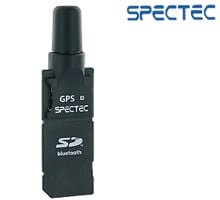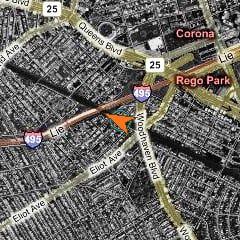Review: Spectec 2-in-1 with Micro SD Memory Slot (SDG-812)


The Spectec 2-in-1 Bluetooth GPS Receiver with Micro SD Memory Slot is a very small, lightweight and fast GPS device that has worked superbly with my 700wx over the last 2 weeks and I have no qualms about recommending it for others, especially novices.
First off, a confession: I'm new to the world of GPS. So for the experienced GPS users out there, I won't be able to compare to every other GPS device on the market. The good news is that I have a feeling there are a lot of people out there who don't use GPS and like myself are curious and bewildered about what is out on the market.
Luckily, for my first GPS device I found what I think is a winner, especially if you are a WM Treo user!

Specifications
First let's throw some specs out there:
- SiRF III chipset, 12 channels (up to 20)
- Communicates via BT
- SDIO interface
- Micro-SD card slot (up to 2gb; not included)
- Weight: 15g
- Cold start up time: 40 s (average)
- Power consumption: 70 to 90mA
- No drivers needed
- Blue LED for signal status
Regarding the chipset, SiRF III, for the uninitiated, is one of the latest GPS technologies on the market. It reportedly has slightly higher power consumption than SiRF II but has a much quicker signal acquisition and can maintain that signal at higher speeds and my tests show this to be accurate.
Also worth noting is the obvious: the built in micro-SD card slot. Granted, you are now forced to buy a micro-SD card if you want to store your iGuidance or TomTom maps, but they are quite cheap now and they are the future of removal storage. The device uses BT to communicate the GPS data and the micro-SD slot is dedicated to storage, as opposed to the older, BT-less SDG-810. The benefit here is no driver, slightly less power consumption, and since it is powered by the phone, no separate charging cables either. Plus your maps and GPS unit are always together, which is a nice benefit.
What's in the Box

There is really not much to be shown here: you get the box, the device and a 1 page paper which are the directions. Since the SDG-812 is OS-independent, there are no drivers or software to install anywhere. In fact, assuming you have a SD slot and BT on your laptop, you could just pop this in and use it there too.
Get the Windows Central Newsletter
All the latest news, reviews, and guides for Windows and Xbox diehards.
Setting Up

Okay, one thing I learned while researching GPS and Windows Mobile: setting it up is not always easy or straight forward, due to some awkward choices by Microsoft e.g. on some devices, under Settings the OEM has hidden the GPS icon, requiring a registry edit to unhide. Luckily on the Palm Treo 700wx this was not an issue as it was already unhidden and overall, setup on this device was fairly effortless.
First, you just insert the SDG-812 into your SD card slot and you'll notice that the blue LED begins to blink. This tells you two things (1) the GPS unit is now powered and (2) you have no signal. The next step is to pair the SDG-812 with your device. Simply launch your BT connections (Settings --> Connections --> Bluetooth), enable and set to discovery. Within moments SPECTEC SD-GPS should appear on your screen. Next, check the Serial Port box under Partnership Settings and hit Save. Finally, you have to specify which COM port to use by first choosing New Outgoing Port, Next and one of the available ports (I've used 4 and 8 with no problems) and then Save.
Finally, under Settings --> System --> GPS set the hardware GPS settings to that same COM port you choose above (COM4 in this case) and under Software GPS, choose any other port besides what you chose for hardware. I advise to write those two COM settings down, just so when you setup your GPS software, you can have a quick reference.
Interestingly, under Baud Rate, there is no option for 38400, the recommended rate for the SDG-812, only 33600. From what I understand, this really not an issue as like a modem you can set it for the lesser value with no problems, but at the end of the review I'll post a simple registry edit to get the 38400 value to show up in WM if you really want it!
[Editor's note: there's also a How-To Video: Setting up Bluetooth GPS on WM5 that you can use]
Lets test it out!
Honestly, there is not too much to say here as it just worked with little bother. You pop it in the phone, launch your GPS software and within a minute you know where you are in the world.

I used the free Turbo GPS to enable the GPS unit and verify satellite connections. Signal acquisition was very quick. The specs say about 40 seconds on average and that is quite accurate and many times, it was slightly faster. Once connected, the blue LED on the SDG-812 stays solid, which is a great way to know that everything is OK. After 8 minutes of non-connectivity, the GPS unit will auto-power off which is a brilliant feature in case you want to keep the unit in your SD card slot but not drain your precious battery Within moments. The SDG-812 connects up to 4-5 satellites and within in a few minutes, depending on location it will increase often connecting up to 10 GPS satellites.
I found no instances of loosing a signal, holding up even inside near windows once the signal was acquired and found it held strong even at high speeds. Case in point, I used it on the Long Island Railroad (speeds up to 80 mph) and was able to literally follow the train route the entire trip, using Windows Mobile Live Search, which pulled the satellite data down fast enough over 3g.
For software, I used a bunch of different types: Google Maps, GPS Info, WM Live Search, Turbo GPS, Tracky Pro and Visual IT's Tube 2 NYC Geo. Just make sure to choose your COM settings in each program. All of them ran without issue, except one: Tube 2 NYC Geo, which had COM port settings that did not match those for the SDG-812, which I suspect is an issue with Visual IT's programming.
Battery life was not bad either -- on par with a regular BT active connection. I would assume that powering the SD receiver does cause some extra strain on the battery and a more rigorous test would prove that, but in my testing it was, as I said, about the same drain as is caused by a Bluetooth connection to an external receiver.
Accuracy was also fairly high, depending on mapping service used, but more often than not it came down to within 5-10 feet of target area. Signal re-acquisition was also extremely fast if you pulled out the unit and/or toggled Bluetooth ("hot start"), which is handy if you go inside for awhile or need to turn it off for an extended duration ("warm start"). In midtown NYC, I found signal acquisition took about a minute or two longer on a "cold start" than in the suburbs, which I attribute to structural interference.
Conclusions

I really liked using the SDG-812, especially as a GPS novice, it just flat-out worked. I did find the included directions a little vague as they used WM 2003 for the screen shots and found myself double checking online for more information. Although it may seem naive, I had no idea you had to be literally outside or near a window to acquire a signal! They also show something called "GPS Viewer" within the directions and I had no idea what that was (turns out it is older software to initiate the GPS unit).
Some other issues to consider are the fact that this uses as SD card interface and newer WM devices are ditching that format altogether opting for mini-SD or, more likely micro-SD, making this unit essentially obsolete for future devices (for example I couldn't test this on my Moto Q or ppc-6700 for that very reason). As the SDG-812 sticks out from your WM phone, it is prone to easily break if you were to drop your device. Furthermore, you won't be able to use your 3rd party horizontal holsters at all while installed, making vertical ones necessary. The SDG-812 does take power from your WM device, as opposed to GPS "pucks" with their own battery. The trade off here is you don't have to charge yet-another-device or worry if you packed the charging cable; the downside is you will inevitably drain your battery slightly faster. Since a lot of people use GPS units for their cars and have car charges, this does not seem much of an issue but it is something to consider if you will be away from a power source for long periods. Finally, you also have to purchase a micro-SD card but as mentioned earlier, these are so cheap now as to almost a non-issue.
Having said that, the price is very reasonable ($89.95), the SiRF III chipset is cutting edge and is quite fast. The SDG-812 is very small and when not in use, easily fits into your pocket (unlike the GPS "pucks"), making it a fantastic option for hiking, walking around the city or even in the car. I like the idea of having all my GPS software and maps installed on the micro-SD card, making the Spectec 2-in-1 Bluetooth GPS Receiver with Micro SD Memory Slot a tiny all-in-1 GPS center.
If you plan on keeping your WM device for awhile then this is a smart buy!
| Ratings (out of 5)Design: 4Ease of Use: 5GPS Signal: 5Directions: 2Overall: 4 | ProsPriceSiRF III technology (fast & accurate)Works with no fussTiny!BT status LEDAuto-shut offConsSD interface is outdated for new WM devicesRequires micro-SD cardDirections are a vague/archaic |
Links of Interest:
Registry Edit to get 38400 Baud Rate to appear in WM5:
HKEYLOCALMACHINE\System\CurrentControlSet\GPS Intermediate Driver\Drivers\Control Panel Configured Device
Under the DWORD Value "Baud", change DWORD Data to 38400.
Power off device for 1 minute and soft-reset.
Home to the most invested and passionate Microsoft fans, Windows Central is the next generation destination for news, reviews, advice and buying recommendations on the Windows, PC and Xbox ecosystems, following all products, apps, software, AI advancements, and accessories. We've been around for more than decade, and we take our jobs seriously. Windows Central writers and editors value accuracy and editorial independence in everything we do, never receiving compensation for coverage and never pulling punches.
